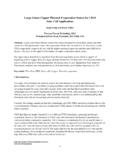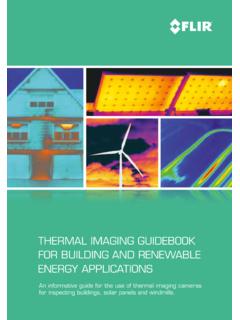Transcription of OCEAN THERMAL ENERGY CONVERSION (OTEC)
1 Marshall DP (1997) Subduction of water masses in aneddying of Marine Research55:201} JC, Nurser AJG and Williams RG (1993).Inferring the subduction rate and period over theNorth of Physical Oceanography23: 1315} S, Rhines PB and Keffer T (1982) North Atlan-tic potential vorticity and its relation to the of Physical Oceanography12:1417} J (1996) OCEAN Circulation Theory. New RT and Regier LA (1992) Vorticity and verticalcirculation at an OCEAN of PhysicalOceanography22: 609} JF (2001) Subduction. In: OCEAN Circulation andClimate: Observing and Modelling the Global OCEAN ,G. Siedler, J.
2 Church and J. Gould (eds), AcademicPress, pp. PB and Schopp R (1991) The wind-driven circula-tion: quasi-geostrophic simulations and theory for non-symmetric of Physical Oceanography21: 1438} RM and Vallis GK (1997) Large-scale circula-tion with small diapycnal diffusion: the two-thermo-cline of Marine Research55: 223} H (1979) Determination of watermass propertiesof water pumped down from the Ekman layer to thegeostrophicSow of the NationalAcademy of Sciences of the USA76: 3051} RG (1991) The role of the mixed layer in settingthe potential vorticity of the main Physical Oceanography21: 1803} RG, Spall MA and Marshall JC (1995) DoesStommel s mixed-layer Demon work?
3 Journal ofPhysical Oceanography25: 3089} JD and Barkmann W (1986) A Lagrangian mixedlayer model of Atlantic 183C water : 574} THERMAL ENERGY CONVERSION (OTEC) S. M. Masutani and P. K. Takahashi,University of Hawaii at Manoa, Honolulu, HI, USAC opyright^2001 Academic THERMAL ENERGY CONVERSION (OTEC) generateselectricity indirectly from solar ENERGY by harnessingthe temperature difference between the sun-warmedsurface of tropical oceans and the colder deepwaters. A signiRcant fraction of solar radiation inci-dent on the OCEAN is retained by seawater in tropicalregions, resulting in average year-round surface tem-peratures of about 283C. Deep, cold water, mean-while, forms at higher latitudes and descends toSow along the seaSoor toward the equator.
4 Thewarm surface layer, which extends to depths ofabout 100}200 m, is separated from the deep coldwater by a thermocline. The temperature difference, T, between the surface and thousand-meter depthranges from 10 to 253C, with larger differencesoccurring in equatorial and tropical waters, as de-picted inFigure 1. Testablishes the limits of theperformance of OTEC power cycles; the rule-of-thumb is that a differential of about 203C is neces-sary to sustain viable operation of an OTEC OTEC exploits renewable solar ENERGY ,recurring costs to generate electrical power areminimal. However, theRxed or capital costs ofOTEC systems per kilowatt of generating capacityare very high because large pipelines and heat ex-changers are needed to produce relatively modestamounts of electricity.
5 These highRxed costs dom-inate the economics of OTEC to the extent that itcurrently cannot compete with conventional powersystems, except in limited niche markets. Consider-able effort has been expended over the past twodecades to develop OTEC by-products, such as freshwater, air conditioning, and mariculture, that couldoffset the cost penalty of electricity of the TechnologyOTEC power systems operate as cyclic heat receive THERMAL ENERGY through heat transferfrom surface sea water warmed by the sun, andtransform a portion of this ENERGY to electricalpower. The Second Law of Thermodynamics pre-cludes the complete CONVERSION of THERMAL ENERGY into electricity.
6 A portion of the heat extracted fromthe warm sea water must be rejected to a colderthermal sink. The THERMAL sink employed by OTEC systems is sea water drawn from the OCEAN depthsby means of a submerged pipeline. A steady-statecontrol volume ENERGY analysis yields the result thatnet electrical power produced by the engine mustequal the difference between the rates of heat trans-fer from the warm surface water and to the colddeep water. The limiting ( , maximum) theoreticalCarnot ENERGY CONVERSION efRciency of a cyclic heatOCEAN THERMAL ENERGY CONVERSION (OTEC)1993 Less than 18 CDepth less than 1000 mMore than 24 C40 S30 S20 S10 SEquator10 N20 N40 N30 N40 E80 E120 E160 E160 W120 W80 W40 W0 WLatitude18 _20 C20 _22 C22 _24 CLongitudeFigure 1 Temperature difference between surface and deep sea water in regions of the world.
7 The darkest areas have thegreatest temperature difference and are the best locations for OTEC scales with the difference between the tem-peratures at which these heat transfers occur. ForOTEC, this difference is determined by Tand isvery small; hence, OTEC efRciency is low. Althoughviable OTEC systems are characterized by CarnotefRciencies in the range of 6}8%, state-of-the-artcombustion steam power cycles, which tap muchhigher temperature ENERGY sources, are theoreticallycapable of converting more than 60% of theextracted THERMAL ENERGY into low ENERGY CONVERSION efRciency of OTEC means that more than 90% of the THERMAL energyextracted from the OCEAN s surface is wasted andmust be rejected to the cold, deep sea water.
8 Thisnecessitates large heat exchangers and seawaterSow rates to produce relatively small amounts spite of its inherent inefRciency, OTEC, unlikeconventional fossil ENERGY systems, utilizes a renew-able resource and poses minimal threat to theenvironment. In fact, it has been suggested thatwidespread adoption of OTEC could yield tangibleenvironmental beneRts through avenues such as re-duction of greenhouse gas CO2emissions; enhanceduptake of atmospheric CO2by marine organismpopulations sustained by the nutrient-rich, deepOTEC sea water; and preservation of corals andhurricane amelioration by limiting temperature risein the surface OCEAN through ENERGY extraction andartiRcial upwelling of deep efRciency applies only to an ideal heatengine.
9 In real power generation systems, irrevers-ibilities will further degrade performance. Given itslow theoretical efRciency, successful implementationof OTEC power generation demands careful engin-eering to minimize irreversibilities. Although OTEC consumes what is essentially a free resource, poorthermodynamicperformancewillreduceth equantity of electricity available for sale and, hence,negatively affect the economic feasibility of anOTEC OTEC heat engine may be conRgured follow-ing designs by D Arsonval, the French engineerwhoRrst proposed the OTEC concept in 1881, orG. Claude, D Arsonval s former student. Their de-signs are known, respectively, as closed cycle andopen cycle Cycle OTECD Arsonval s original concept employed a pureworkingSuid that would evaporate at the temper-ature of warm sea water.
10 The vapor would sub-sequently expand and do work before beingcondensed by the cold sea water. This series of stepswould be repeated continuously with the sameworkingSuid, whoseSow path and thermodynamicprocess representation constituted closed loops}hence, the name closed cycle. The speciRc pro-cess adopted for closed cycle OTEC is the Rankine,or vapor power, 2is a simpliRed sche-matic diagram of a closed cycle OTEC system. Theprincipal components are the heat exchangers,turbogenerator, and seawater supply system, which,although not shown, accounts for most of the para-sitic power consumption and a signiRcant fractionof the capital expense.







